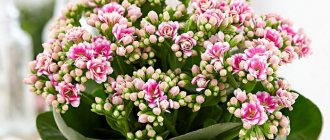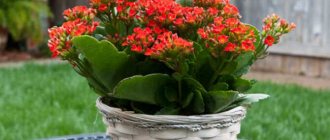Author: Elena N. https://floristics.info/ru/index.php?option=com_contact&view=contact&id=19 Category: Houseplants Published: February 10, 2019Last edits: January 11, 2021
- Cuttings
- Diseases and their treatment
Chrysanthemum flowers belong to the genus of herbaceous annuals and perennials of the Compositae, or Asteraceae, family. The genus includes about 30 species, representatives of which grow in zones with cool and temperate climates, mostly in Asia. Chrysanthemum has been known in garden culture for more than a thousand years, and the plant came to Europe in the 17th century. Many chrysanthemums can be grown outdoors, but there are species that grow well in greenhouses and at home.
How to care for chrysanthemums in pots in winter
Chrysanthemums bloom for a short time, after which they go into a long dormant mode. It is this moment that many perceive as the death of the plant and get rid of it. But perennial varieties can once again delight you with flowers after wintering.
So, what needs to be done to provide wintering for a perennial chrysanthemum?
First, you need to ruthlessly but carefully trim the bush, almost to the root, leaving small stumps. Now the pot with the plant needs to be moved to a cold place, the temperature in which varies from 0 to +5 degrees. Throughout the winter, until the first signs of growth appear, the flower is not watered or fed.
As soon as you notice that the plant begins to perk up, move it to a cool place with bright lighting. For example, on the balcony.
Chrysanthemum does not tolerate heat at any stage of development. Even in summer, during the flowering period, it needs to ensure a temperature regime of no more than 23 degrees Celsius. In hotter environments, the flowers will quickly fall off and the foliage will turn yellow.
When the plant begins to grow, it needs to be transplanted into new soil. An ordinary flower mixture, which is sold in any supermarket or flower shop, is suitable for this. At the same stage, you can fertilize. We'll talk about this below.
In addition to high temperatures, chrysanthemum does not like direct sunlight. The ideal place to live would be the east or west side of the house. But you shouldn’t place it on a windowsill on the north side; here it may not even bloom.
Description of the plant
Chrysanthemum is an annual or perennial herbaceous plant native to Asia. It is found naturally in China and Japan. It was there that this flower was first grown in the garden.
Chrysanthemums can be either high (50-60 cm) or low - up to 25-30 cm in height. Strongly cut leaves, painted light green, alternately sit on bare or pubescent shoots.
Chrysanthemums bloom from spring to autumn, forming flowers in the form of small or large baskets. Flowers can be single, double or semi-double. The color of the petals depends on the type and variety of the plant. There is no smell.
Preparing the soil for planting chrysanthemums
The soil where the chrysanthemum will grow should be loose, airy, enriched with nutrients and neutral. As I already said, in stores you can buy special mixtures directly for chrysanthemums. But you can do it yourself.
To do this, you need to mix humus, turf soil and sand in equal parts. You need to mix thoroughly until smooth.
To increase the nutrient content of the soil, you can add a little chicken manure to it.
Growing chrysanthemums in acidic soil will not give you results.
Care errors and their elimination
Problems when growing Chrysanthemums and their elimination:
| Problem | Causes | Solution |
| Yellowing of leaves | Lack of light, lack of moisture, hot air | Place the flower in bright, diffused light, control the length of daylight hours, spray the leaves in the heat |
| Wilting leaves | Improper watering | Water the plant regularly, but moderately, do not over-moisten or dry out the soil. |
| No flowering | Too hot air, poor soil, lack of pinching | Before flowering, lower the temperature to +15 degrees, apply complex fertilizers during the growing season, pinch the tops of the stems to stimulate the growth of side shoots |
How to water home chrysanthemums and what humidity to maintain
Blooming beauties love moderate watering. They do not tolerate either excess moisture or prolonged drought. You need to ensure that the soil is always moist.
It is recommended to drain excess moisture immediately after watering. And before the next application of water, the soil surface should dry out just a little.
As for humidity, it is sufficient for chrysanthemums, subject to timely watering. During the heating season, you can spray the bushes with water from a spray bottle. The main thing is to avoid getting on the inflorescences.
Fertilizing potted chrysanthemums at home
For richer and longer flowering, chrysanthemums, like any other plants, are recommended to be fed. The bushes need special nutrition all the time before leaving for the winter. Fertilizers need to be applied frequently, just like garden plants. It is better to do this at least once a week or at least every 2 weeks.
Special mixtures for chrysanthemums or universal flower mixtures are suitable as fertilizers. During the flowering period, it especially urgently needs potassium and phosphorus, and at the stage of bush formation - nitrogen. Therefore, these substances need to be increased in the mineral complex, according to the stage of development of the bush.
Actions in the absence of flowering
If proper care is provided, flowering occurs in the fall. The absence of this phenomenon indicates a violation of the rules of care. With late pruning, lack of light, unsuitable soil and lack of fertilizing, buds do not form. With these problems eliminated, the bush will grow and delight with beautiful flowers.
During flowering, it is necessary to remove dried foliage and flowers, otherwise the chrysanthemum dries out. The indoor plant perfectly decorates the windowsill, balcony and loggia. Thanks to the variety of flower shapes, you can choose the right variety. And with proper care, the plant will always look attractive.
How to properly trim and shape chrysanthemum bushes
To make the bush look beautiful, it needs to be pinched and trimmed. In a word – form. Only then will it always please the eye, have a beautiful spherical crown and bloom longer.
1.As flowers and leaves fade, they need to be trimmed. And this needs to be done as quickly as possible so that they are replaced by new leaves and inflorescences.
2. Before wintering, you need to trim the plant as much as possible, leaving only small stumps from the roots.
3. In order for the bush to form a beautiful cap, the tops need to be pinched. This must be done at least 2 times – in spring and in the first half of summer. In addition, if you notice that the plant is lengthening, losing its spherical shape, you can pinch it again. Pinching occurs as follows - a small part of the top is cut off with pruners or scissors. As a result, upward growth stops and the bush grows wider.
Methods and methods for propagating potted chrysanthemums
There are 3 main ways to propagate home chrysanthemums:
1. Separation of adult bushes. This method is carried out before winter or after flowering ends. The bush is carefully removed from the soil and disassembled from the root. This must be done extremely carefully so as not to damage the rhizome.
2.Seeds. This method is quite troublesome. Although the seeds germinate well, the plant itself requires a long wait. After all, you will have to wait for more than one year for flowering.
3.Method of cuttings. We have already considered this option a little higher. You can cut a cutting from a bouquet flower or pick it from a garden bed. Then you need to pinch the top, remove all the leaves and the flower. Then you need to root the stick in water or moistened soil. After this, the cuttings are planted in pots. This is done either in a large container, at a distance of at least 30 centimeters from each other, or in separate medium-sized pots.
A little history
Chrysanthemums are herbaceous annual and perennial plants belonging to the Asteraceae family, which includes 29 species. For thousands of years, they have grown in temperate and cool climates, usually in Asia.
In Europe, plants began to be cultivated in the 17th century. The chrysanthemum is considered a symbol of the imperial family in Japan. In China, the plant is considered medicinal; drugs are made on its basis for the treatment of gastrointestinal tract, eye ailments, migraines, and nervous diseases. The room also becomes more comfortable if there is a homemade chrysanthemum in a pot. How to care for it so that the flower actively develops? It is required to follow simple rules, which will be discussed below.
Possible diseases of home chrysanthemum
Even with seemingly proper care, the chrysanthemum may not bloom or even die. The situation is, of course, unpleasant, but this is not a reason to give up and not grow chrysanthemum at home. Perhaps the reason is one of the diseases that most often affects this plant.
Septoria blight
A very harmful disease. It is expressed in the appearance of gray spots on the leaves. It's a fungus. It can be prevented or eliminated at an early stage by treating with copper sulfate. If the disease has affected the entire plant from top to bottom, then it must be burned.
Bacterial cancer
You can identify it by the presence of seals on the leaves and stems. The culprit is a soil bacterium. It affects the stems and they become fleshy and dense, which interferes with flowering and leads to the death of the flower. To save your plant, remove leaves and stems as soon as new growths are detected.
White rust
First, plump light spots form on the tops of the leaves. Then they become darker. Affected leaves should be immediately removed, and the plants themselves should be treated with copper oxychloride. If the entire flower is damaged, it must be burned.
Powdery mildew
The disease can be easily identified by its characteristic plaque. At the initial stage, you need to treat the plant with Apirin B. If the disease has spread on a large scale, it is worth using heavy artillery - Pure Flower, Sling, Topaz, and so on. As a preventative measure, the soil is periodically enriched with phosphorus and potassium. In this case, feeding should be done exclusively at the root, without touching the leaves. The lower leaves should be cut off. This trouble can spread to other plants adjacent to the infected flower. In this case, it is better to get rid of it.
Vetricillium wilt
The disease is characterized by early wilted leaves. Moreover, they do not fall off. Such a specimen needs to be cut off, and the unaffected bush should be treated with Apirin B.
Ascochyta rot
A rapidly progressing disease, which is characterized by the presence of dark spots on the leaves and rapid wilting of the plant. Before the flower is completely dead, you need to cut off all the affected areas. Change the pot and soil. The planting material should be completely treated with benlate or topsin. After replanting, ensure normal humidity and regular ventilation of the room where the plant grows.
Stem rot
Another harmful disease that can destroy a plant. In this case, the flower quickly withers, and the stem acquires a brown tint. Such a copy must be immediately destroyed. Healthy flowers are treated after removing the infected one. The appearance of this disease may be affected by the lack or poor quality of drainage.
Lush flowers on an astonishing scale
Chrysanthemums are so popular at the end of the season not only because the color palette ideally represents the so-called autumn palette. The colors of chrysanthemum flowers really perfectly highlight the crimson-fiery autumn colors. But no color nuances can overshadow the main thing - tireless and very long flowering, unique in its scale and abundance. In addition, potted chrysanthemums have a wide variety of varietal colors.
Potted chrysanthemum. © bittster
Potted chrysanthemums that cannot withstand winter frosts can be grown in two forms:
- Seasonal indoor or balcony annual;
- A perennial that is put indoors for the winter and pruned after a dormant period, stimulating growth.
Potted chrysanthemums can also be planted in open soil - but then they will need to be dug up and transferred to pots for wintering. Therefore, they are most often grown in container culture.
Chrysanthemums in container form differ from their garden counterparts. They develop in the form of dense, cushion-shaped bushes, formed by pruning and bred specifically to produce specimens of increased density. Numerous shoots become woody, dotted with simple carved leaves, which most often do not create a particularly impressive crown, but merely serve as a background for the flowers. They bloom at the tops of the shoots in such numbers that they create continuous caps.
Classic basket inflorescences of potted chrysanthemums can be simple or densely double, with wider or very narrow reed petals. And the color, which includes all the warm shades of white-cream, yellow, orange, red, purple, brown, can be either monochromatic or combined and even contrasting.
Today, new blue-flowered chrysanthemums and original green-flowered plants are in fashion, as well as varieties with dazzling acrylic colors. Large-flowered varieties are even more popular - hybrids with spherical, pom-pom, anemone-shaped inflorescences, which decorate gardens throughout the warm months, and bloom indoors throughout the fall and winter.
Potted chrysanthemums vary in size. For indoor cultivation and indoor cultivation, mini-varieties are chosen, the height of which does not exceed 30 cm. But the specimens intended for open air are twice as large, sometimes reaching 1 meter in height and diameter. Potted chrysanthemums can be standard, shaped like a ball, squat, or even splayed. In a word, there is plenty to choose from. Moreover, indoor chrysanthemums are sold in bloom throughout the year, while garden chrysanthemums today appear on the shelves in the spring, specially driven out at atypical times. But such “early maturing” plants are just a temporary decoration for both the house and the garden, which will have to be thrown away. If you want to preserve chrysanthemums, buy them during the typical flowering time - from late summer through autumn. When purchasing, be sure to check exactly what conditions the chrysanthemums are accustomed to and how they need to be grown: sometimes locally distilled chrysanthemums require specific care.
Potted chrysanthemum. © Karen Maraj
In order for potted chrysanthemums to bloom truly profusely, they will require simple but constant care and rather specific conditions. They bloom luxuriantly at low temperatures, and this requirement can be ignored only when grown as an annual plant or taken out into the fresh air. Watering and fertilizing are frequent, but other than that, there are usually no difficulties with chrysanthemums.
Pests of indoor chrysanthemum
Have you decided to decorate your home with a beautiful chrysanthemum bush? In addition to basic care and possible plant diseases, you need to know what pests you should be careful of.
Western flower thrips
If this pest has settled on a flower, it will soon be covered with pronounced yellowish spots. You need to get rid of such a flower immediately.
Spider mite
It settles mainly on the lower leaves of the plant, gluing its web onto the leaves. They suck the juice from the leaves, after which the bush begins to die. To get rid of them at the initial stage, you can take the bush outside in hot weather and spray it with water. The affected leaves are treated with a soap solution. Chemicals such as Akarin or Lightning, for example, help against larger-scale invasions.
Field bug
They suck out the juice and the chrysanthemum dies. The leaves curl up. If you notice these pests, remove them along with the leaves. And treat the already clean plant with karbofos and green potassium soap.











